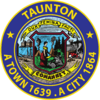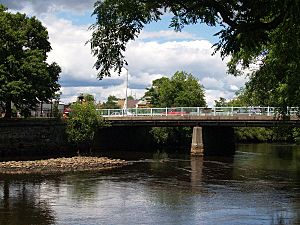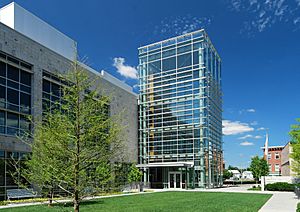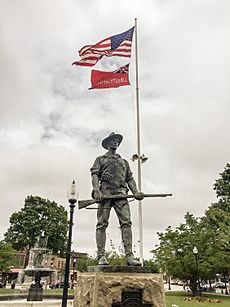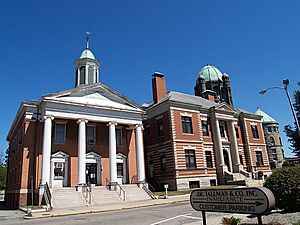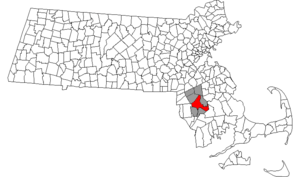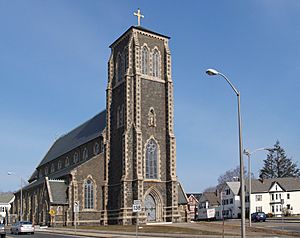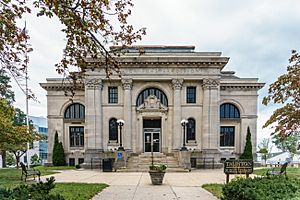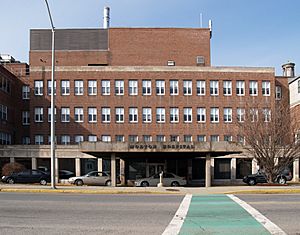Taunton, Massachusetts facts for kids
Quick facts for kids
Taunton, Massachusetts
|
|||
|---|---|---|---|
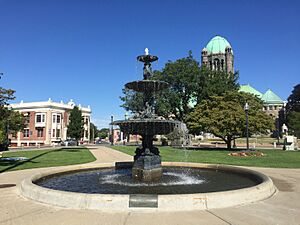
Taunton Green
|
|||
|
|||
| Nickname(s):
The Silver City, The Christmas City
|
|||
| Motto(s):
Dux Femina Facti (Latin)
"A woman led the deed." |
|||
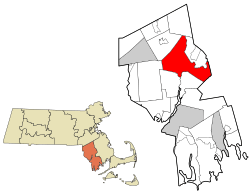
Location in Bristol County, Massachusetts
|
|||
| Country | United States | ||
| State | Massachusetts | ||
| County | Bristol | ||
| Settled | 1637 | ||
| Incorporated (Town) | 1639 | ||
| Incorporated (City) | 1864 | ||
| Named for | Taunton, England | ||
| Government | |||
| • Type | Strong mayor / Council | ||
| Area | |||
| • Total | 48.41 sq mi (125.39 km2) | ||
| • Land | 46.71 sq mi (120.97 km2) | ||
| • Water | 1.71 sq mi (4.42 km2) | ||
| Elevation | 30 ft (9 m) | ||
| Population
(2024)
|
|||
| • Total | 60,941 | ||
| • Density | 1,271.90/sq mi (491.08/km2) | ||
| • Demonym | Tauntonian | ||
| Time zone | UTC−5 (Eastern) | ||
| • Summer (DST) | UTC−4 (Eastern) | ||
| ZIP Codes |
02718, 02780, 02783
|
||
| Area code(s) | 508 / 774 | ||
| FIPS code | 25-69170 | ||
| GNIS feature ID | 0613154 | ||
Taunton is a city in Massachusetts, United States. It's also the main city for Bristol County. Taunton sits on the Taunton River, which flows through the city and out to Mount Hope Bay, about 16 kilometers (10 miles) south. In 2020, about 59,408 people lived here. Shaunna O'Connell is the current mayor of Taunton. A mayor is like the chief executive of a city, leading its government.
Taunton was started in 1637 by settlers from the Plymouth Colony. This makes it one of the oldest towns in the United States! It's also known as the "Silver City." This nickname comes from the 1800s when many companies made beautiful silver items here. Famous companies like Reed & Barton and F. B. Rogers produced high-quality silver goods.
Since 1914, Taunton has put on a huge light display every December on Taunton Green. This tradition gives it another nickname: the Christmas City.
The original area of Taunton was much bigger than it is today. It included land that is now many nearby towns. These towns include Norton, Easton, Mansfield, Dighton, Raynham, Berkley, and Lakeville.
Contents
- Discover Taunton: A City's Journey
- Famous People from Taunton
- Sister Cities
- See also
Discover Taunton: A City's Journey
A Look Back: Taunton's History
Early Days and Founding
Taunton was founded by settlers from England. It officially became a town on September 3, 1639. Most of the first settlers came from a town called Taunton in England. They named their new home after their old one to honor their "dear native country." Before 1640, the area was known by Native American names like Cohannet or Tetiquet.
The English founders bought the land from the Wampanoag Native Americans in 1637. This was part of the Tetiquet Purchase. The remaining Native families moved to a special town called Ponkapoag. Elizabeth Poole was a very important person in Taunton's early days. She helped fund the first dam and mill, which made iron. She is often called "the foundress of Taunton."
In 1685, Plymouth Colony was divided into counties. Taunton became the main town for Bristol County. The area has seen battles during different conflicts, like King Philip's War and the American Revolution. Taunton officially became a city on May 11, 1864.
Industrial Growth and Nicknames
In 1656, the first successful iron works in Plymouth Colony started near Taunton. This was just the beginning of many iron industries in the city.
During the 1800s, Taunton earned its "Silver City" nickname. Many companies made silver products here, like Reed & Barton and Poole Silver.
Taunton was also a big center for making iron. They used iron found in local swamps. The iron industry made many things, including stoves and machinery. One famous company, Mason Machine Works, built machines for textile factories and even steam locomotives.
The city also had textile mills and other factories. Taunton was an important shipping point for grain. It also became a major transportation hub because of its central location and the arrival of railroads.
In 1897, Taunton started its own public electric company, the Taunton Municipal Light Plant (TMLP). Today, TMLP provides electricity to many homes and businesses in Taunton and nearby towns.
Recent Times: The 20th and 21st Centuries
During World War II, Camp Myles Standish was built in Taunton in 1942. Over a million American and allied soldiers left from here for Europe. It was also a camp for German and Italian prisoners of war. After the war, the camp closed in 1946. Part of the land became the Myles Standish Industrial Park. This park is now one of the largest in New England, with many manufacturing and tech companies.
The National Weather Service has a regional weather forecast office in Taunton. This office helps predict weather for much of Massachusetts, Rhode Island, and Connecticut.
In 2005, a dam near downtown Taunton, the Whittenton Pond Dam, almost broke after heavy rains. Over 2,000 people had to leave their homes. The mayor declared a state of emergency. If the dam had failed, the downtown area could have been flooded with up to 1.8 meters (6 feet) of water.
In 2010, the historic Taunton City Hall was badly damaged by a fire. The city government worked from another building for ten years. The City Hall was finally repaired and reopened in 2020.
In 2012, Taunton was considered for a Wampanoag casino complex. This idea caused some debate, especially because the proposed location was near an elementary school and a technical high school.
Taunton is also home to a General Dynamics Mission Systems factory. This factory develops equipment for military communications.
City Layout: Geography and Climate
Taunton covers about 125.4 square kilometers (48.4 square miles). Most of this is land, with about 4.4 square kilometers (1.7 square miles) of water. It's the third-largest city in Massachusetts by area.
The main river in Taunton is the Taunton River. It has smaller rivers flowing into it, like the Mill River and the Three Mile River. The highest point in the city is about 63 meters (207 feet) above sea level.
Taunton has a climate with hot summers. This means it has warm, humid summers and cold, snowy winters.
| Climate data for Taunton, Massachusetts, 1991–2020 normals, extremes 1997–present | |||||||||||||
|---|---|---|---|---|---|---|---|---|---|---|---|---|---|
| Month | Jan | Feb | Mar | Apr | May | Jun | Jul | Aug | Sep | Oct | Nov | Dec | Year |
| Record high °F (°C) | 71 (22) |
70 (21) |
84 (29) |
94 (34) |
96 (36) |
99 (37) |
100 (38) |
103 (39) |
95 (35) |
87 (31) |
80 (27) |
76 (24) |
103 (39) |
| Mean maximum °F (°C) | 59.9 (15.5) |
58.1 (14.5) |
66.9 (19.4) |
78.9 (26.1) |
88.5 (31.4) |
91.6 (33.1) |
95.5 (35.3) |
93.0 (33.9) |
89.1 (31.7) |
80.2 (26.8) |
70.7 (21.5) |
63.1 (17.3) |
97.2 (36.2) |
| Mean daily maximum °F (°C) | 38.0 (3.3) |
40.0 (4.4) |
47.5 (8.6) |
58.7 (14.8) |
69.5 (20.8) |
77.8 (25.4) |
83.6 (28.7) |
82.4 (28.0) |
75.0 (23.9) |
63.1 (17.3) |
52.6 (11.4) |
43.3 (6.3) |
61.0 (16.1) |
| Daily mean °F (°C) | 28.8 (−1.8) |
30.7 (−0.7) |
38.0 (3.3) |
48.1 (8.9) |
58.7 (14.8) |
67.3 (19.6) |
73.2 (22.9) |
72.2 (22.3) |
64.7 (18.2) |
53.0 (11.7) |
43.4 (6.3) |
34.5 (1.4) |
51.1 (10.6) |
| Mean daily minimum °F (°C) | 19.7 (−6.8) |
21.4 (−5.9) |
28.5 (−1.9) |
37.5 (3.1) |
47.8 (8.8) |
56.8 (13.8) |
62.8 (17.1) |
62.0 (16.7) |
54.3 (12.4) |
43.0 (6.1) |
34.1 (1.2) |
25.7 (−3.5) |
41.1 (5.1) |
| Mean minimum °F (°C) | −0.8 (−18.2) |
1.7 (−16.8) |
10.7 (−11.8) |
23.2 (−4.9) |
32.1 (0.1) |
40.9 (4.9) |
49.5 (9.7) |
45.9 (7.7) |
34.7 (1.5) |
25.3 (−3.7) |
17.3 (−8.2) |
8.1 (−13.3) |
−3.1 (−19.5) |
| Record low °F (°C) | −12 (−24) |
−16 (−27) |
−6 (−21) |
14 (−10) |
27 (−3) |
36 (2) |
43 (6) |
42 (6) |
31 (−1) |
19 (−7) |
10 (−12) |
−3 (−19) |
−16 (−27) |
| Average precipitation inches (mm) | 3.72 (94) |
3.43 (87) |
5.05 (128) |
4.75 (121) |
3.38 (86) |
4.08 (104) |
3.50 (89) |
3.61 (92) |
3.88 (99) |
4.28 (109) |
4.15 (105) |
4.94 (125) |
48.77 (1,239) |
| Average snowfall inches (cm) | 8.3 (21) |
7.0 (18) |
4.9 (12) |
1.6 (4.1) |
0.0 (0.0) |
0.0 (0.0) |
0.0 (0.0) |
0.0 (0.0) |
0.0 (0.0) |
0.0 (0.0) |
0.2 (0.51) |
3.7 (9.4) |
25.7 (65.01) |
| Average precipitation days (≥ 0.01 in) | 10.6 | 7.5 | 8.6 | 10.2 | 11.1 | 9.5 | 8.8 | 9.4 | 9.5 | 9.0 | 10.1 | 10.3 | 114.6 |
| Average snowy days (≥ 0.1 in) | 3.6 | 2.5 | 2.0 | 0.2 | 0.0 | 0.0 | 0.0 | 0.0 | 0.0 | 0.0 | 0.1 | 1.3 | 9.7 |
| Source 1: NOAA | |||||||||||||
| Source 2: National Weather Service (mean maxima/minima 2006–2020) | |||||||||||||
Historic Areas and Neighborhoods
Taunton has nine special historic districts. These are areas with important old buildings or features. Some examples include the Church Green Historic District and the Taunton Green Historic District.
The city's shape is a bit unusual because towns were separated from its original area. Taunton is bordered by towns like Norton, Easton, and Raynham.
Taunton has many neighborhoods, such as East Taunton, North Taunton, and Weir Village. The city is also home to most of Massasoit State Park and a large part of the Hockomock Swamp Wildlife Management Area.
Who Lives in Taunton?
| Historical population | ||
|---|---|---|
| Year | Pop. | ±% |
| 1790 | 3,804 | — |
| 1800 | 3,860 | +1.5% |
| 1810 | 3,907 | +1.2% |
| 1820 | 4,520 | +15.7% |
| 1830 | 6,042 | +33.7% |
| 1840 | 7,645 | +26.5% |
| 1850 | 10,441 | +36.6% |
| 1860 | 15,376 | +47.3% |
| 1870 | 18,629 | +21.2% |
| 1880 | 21,213 | +13.9% |
| 1890 | 25,448 | +20.0% |
| 1900 | 31,036 | +22.0% |
| 1910 | 34,259 | +10.4% |
| 1920 | 37,137 | +8.4% |
| 1930 | 37,355 | +0.6% |
| 1940 | 37,395 | +0.1% |
| 1950 | 40,109 | +7.3% |
| 1960 | 41,132 | +2.6% |
| 1970 | 43,756 | +6.4% |
| 1980 | 45,001 | +2.8% |
| 1990 | 49,832 | +10.7% |
| 2000 | 55,976 | +12.3% |
| 2010 | 55,874 | −0.2% |
| 2020 | 59,408 | +6.3% |
| 2023* | 60,412 | +1.7% |
| * = population estimate. Source: United States Census records and Population Estimates Program data. Source: |
||
In 2000, about 55,874 people lived in Taunton. The city is very diverse, with people from many different backgrounds. Many residents have Portuguese, Irish, English, or French heritage. A large number of immigrants came to Taunton around the 1900s to work in the city's factories.
About 24.9% of the population was under 18 years old. The average age was 36.
What Drives Taunton's Economy?
Taunton's economy used to be focused on making silver items and building ships. Reed & Barton, a Taunton company, even made the medals for the 1996 Summer Olympics! The city also produced the anchor for the famous ship USS Constitution.
Today, Taunton's economy focuses on technology. This includes making semiconductors, silicon, and other electronics. Many big companies have their main offices here. The city is also trying to attract companies that do biotechnology research.
The Silver City Galleria was a large shopping mall in Taunton. It served Taunton and many nearby towns for 28 years. It closed in 2020 and was taken down in 2021.
Arts, Culture, and Fun Places
Public Spaces to Explore
The Taunton Green is the main square in the city. Long ago, it was used for training soldiers during the American Revolution. Some people believe the historic "Liberty & Union" flag was first raised here in 1774.
Since the early 1900s, Taunton Green becomes a huge display of holiday lights every December. This is why Taunton is called the "Christmas City." The Green is still a central spot for Christmas events, parades, and other city activities. A fountain sits in the middle of the Green. You can always see the "Liberty & Union" flag flying next to the U.S. flag there.
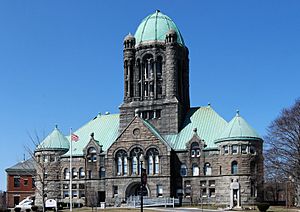
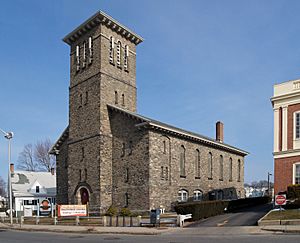
The city has a public library, the Taunton Public Library. It opened in 1903 and has been updated many times. The Old Colony Historical Society also helps preserve the city's past.
Taunton is home to two state parks: Massasoit State Park in East Taunton and Watson Pond State Park. These are great places to enjoy nature.
Buildings and Design
Taunton has many different types of buildings. Some homes date back to the colonial period, before the American Revolution. The oldest house, the Joseph Willis House, was built around 1688. More than a hundred buildings in the city are listed on the National Register of Historic Places.
One of the most impressive buildings is the Bristol County Superior Courthouse. Built in 1894, its tall copper dome can be seen from far away.
Other important buildings include beautiful stone churches. These include the First Parish Church (1830) and St. Mary's Church (1868). Downtown Taunton also has many historic commercial buildings from the 1800s and early 1900s.
The Central Fire Station is the oldest working fire station in the United States. The historic Taunton City Hall is right next to Church Green.
Museums and Art
The Old Colony Historical Society is one of New England's oldest historical groups. It's located on Church Green. Founded in 1853, it has a museum with local items and a library for history research. It also hosts art and cultural events.
Taunton has four art galleries: Taunton Art Association, Hughes/Donahue Gallery, Art Euphoric, and the Trescott Street Gallery. These galleries show art from local artists and beyond.
Taunton on Screen
In 2008, Hollywood director Martin Scorsese filmed parts of his movie Shutter Island in Taunton. The movie starred Leonardo DiCaprio. Another movie, Surrogates, starring Bruce Willis, was also partly filmed here.
Learning in Taunton: Education
Taunton offers education from preschool all the way to college.
Public Schools
Taunton has nine public elementary schools and three public middle schools.
- Elementary Schools: Edmund Hatch Bennett, East Taunton, Harold H. Galligan, Hopewell, Joseph C. Chamberlain, Elizabeth Pole, Mulcahey.
- Middle Schools: Benjamin A. Friedman, Joseph H. Martin, John F. Parker.
The city has three public high schools: Taunton High School, Taunton Alternative High School, and Bristol-Plymouth Regional Technical School.
Private Schools
Taunton has one Catholic school, Our Lady of Lourdes School. It serves students from Pre-Kindergarten to 8th grade.
College and Beyond
Taunton is home to a campus of Bristol Community College. This college offers higher education courses. There are also career schools like the Rob Roy Academy for beauty. Bristol-Plymouth Regional Technical School also offers classes for adults.
Staying Connected: Media and News
TV and Radio
Taunton has local cable TV channels for the public, schools, and government. These include Taunton Community Access and Media, Taunton Educational Network (run by Taunton High School), and Taunton Municipal Network.
The city has two radio stations: AM 1530/99.7 FM WVBF and WSNE-FM 93.3. WVBF offers local programs and services for the visually impaired. WSNE-FM mainly serves the Providence, Rhode Island, area.
Newspapers
You can read about Taunton in several newspapers. These include the Silver City Bulletin, Brockton Enterprise, and the Taunton Daily Gazette. Larger regional papers like the Boston Globe are also available.
Internet Access
Major internet providers in Taunton include Comcast and Verizon. The Taunton Municipal Lighting Plant (TMLP), which provides electricity, also offers internet service to the city.
City Services: Infrastructure
Fire Department
The Taunton Fire Department (TFD) has 127 firefighters. They operate from five fire stations across the city. They have five engines, three ladders, and other special vehicles. The current Chief is Timothy J. Bradshaw.
Healthcare and Utilities
Taunton has Morton Hospital and Medical Center. This hospital provides healthcare services to the community.
Taunton State Hospital is a psychiatric hospital. It provides long-term care for patients with mental health needs.
The Taunton Municipal Lighting Plant (TMLP) provides electricity. The city also has its own water system and a public sewer system.
Getting Around: Transportation
The Taunton Railway started in 1838. It was a major way to transport goods and people. It connected Taunton to cities like New Bedford, Fall River, and Boston.
Taunton is a central point for highways in southeastern Massachusetts. Major routes like US 44, MA 138, and MA 140 meet at Taunton Green. Interstate 495 runs through the northern part of the city.
Several freight train tracks run through Taunton. There are also plans to extend MBTA Commuter Rail service to Taunton. This would allow people to travel by train to Boston and other cities. The Greater Attleboro Taunton Regional Transit Authority (GATRA) provides local bus service.
Taunton has its own municipal airport for smaller planes. For national and international flights, people use T.F. Green Airport in Rhode Island or Logan International Airport in Boston.
Famous People from Taunton
Many interesting people have come from Taunton! You can find a list of them in the main article about people from Taunton.
Sister Cities
Taunton has "sister city" relationships with other cities around the world. This means they share cultural ties and friendly connections.
 Taunton, Somerset, England, United Kingdom
Taunton, Somerset, England, United Kingdom Angra do Heroismo, Terceira, Azores, Portugal
Angra do Heroismo, Terceira, Azores, Portugal Lagoa (Azores), Sao Miguel, Azores, Portugal
Lagoa (Azores), Sao Miguel, Azores, Portugal
See also
 In Spanish: Taunton (Massachusetts) para niños
In Spanish: Taunton (Massachusetts) para niños



